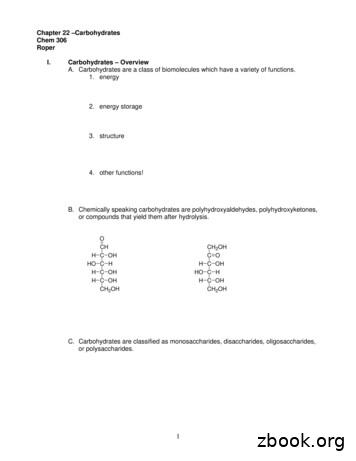Macromolecules Carbohydrates
MacromoleculesCarbohydratescarbohydrates, lipids, proteins, nucleic acids Monomers and Polymers– dehydration reactions Carbohydrates– Sugars and starches Lipids– Fats and oils– Phospholipids– How soap works Start proteins, if time10 Sept. 2021Aldoses(Aldehyde Sugars)Sugars(Understand, but don tmemorize structures)Ketoses(Ketone Sugars)MonosaccharidesTrioses: three-carbon sugars (C3H6O3)GlyceraldehydeDihydroxyacetonePentoses: five-carbon sugars (C5H10O5)RiboseGlucoseRibuloseHexoses: six-carbon sugars (C6H12O6)RiboseGlucose GalactoseFigure 5.2(a) Dehydration1Fructosereaction: synthesizing a polymer2Simple sugars can be linked byDehydration reactions3Dehydration removes a watermolecule, forming a new bond.123H 2OCH2OHO H1OH4(b) Hydrolysis: breaking down a polymerGlucose123Hydrolysis adds a watermolecule, breaking a bond.1234CH2OHO2HHOCH2OHFructoseCH2OHO H1CH2OHO2OH 2OCH2OHSucroseSucrose is a commondisaccharide:Glucose FructoseH 2OH1
Other common disaccharidesCellulose10 µm0.5 µmCellulosemoleculesDo notmemorizeβ GlucosemonomerSmall difference in structure,big difference in function.Fig. 5-8Lipids (fats and JPGFried dough with lard . . . .Fats or triglyceridesFATS(glycerol 3 fatty acids)SolidGlycerolOCOHHCOHCOHHCHOHOCHCHOFat moleculeHCOCHCHOHCHFigure HCHHDehydration reactionOHCCHHHOILS Fatty ilic or hydrophobic?SaturatedUnsaturated orPolyunsaturatedLikeFig 5-122
Polar(charged)HeadWhat are trans fats?Fatty Acids“Amphipathic”VeryHydrophobicTailIn waterthey canform a“micelle”-- why? PhospholipidsWhy soap works– Glycerol 2 fatty acids phosphateHydrophilic headHydrophilic headsHydrophobic tailsGreasy mess onplateCH2O Grease is attracted to the interiorof the miceleFigure 5.13O– N(CH )3 3CholinePhosphateOCH2CHOOCO CCH2GlycerolHow willphospholipidsbehave in water?OFatty acidsHydrophobic tailsSoap miceleCH2OPHydrophilic headHydrophobictails(a) Structural formulaPhospholipid BilayerProteinsFormBoundariesWhat are some ofthe functions ofproteins?3
Nonpolar Side ChainsPolymers of Amino Acids Amino Acids differ only by their R group 20 kinds of amino acids– Same chasis, different cargoNonpolarOilPolarOHChargedSHGlycine(Gly or G)Alanine(Ala or A)Valine(Val or V)Leucine(Leu or L)Isoleucine(Ile or I)R5DuracellCan Keep addingto the endPolar Side ChainsMethionine(Met or M)Phenylalanine(Phe or F)Tryptophan(Trp or W)Proline(Pro or P)Charged Side ChainsBasic (positively charged)Acidic (negatively charged)Serine(Ser or S)Threonine(Thr or T)Cysteine(Cys or C)Aspartic acid Glutamic acid(Asp or D)(Glu or E)Tyrosine(Tyr or Y)Asparagine(Asn or N)Lysine(Lys or K)Arginine(Arg or R)Histidine(His or H)Glutamine(Gln or Q)The amino and acid groupscouple the monomers together4 Levels of StructurePrimary Structure:Amino acid sequence Can make polymers that are 100s or 1000s of aminoacids longR5R1R2R3R4Tertiary Structure:3-D shape of onepolypeptideCan Keep addingto the endSecondary Structure:Local foldingα helix and β sheetQuaternary Structure:Assembly of severalpolypeptides to formone functional protein4
Stopped hereNucleic AcidsATPNucleotidesNucleotides have three components Sugar Base PhosphateUse dehydration reactions toconnect these molecules32Carbons in the sugar arenumbered with primesPurinesA, GPyrimidinesThe bases each have a polar edge forhydrogen bondingThymineAdenineCytosineGuanineC, T, U5
The nucleotide ATP is a commonenergy carrierPolynucleotide (DNA, RNA)chains are assembled by yetanother type of dehydrationreaction5endThese are high-energy phosphate bonds Link the -OH on the 3 carbonof one nucleotide to the phosphate on the 5carbon of the next.Also GTP, CTP, etc.RNA3endDNADNA copyingis the basisof heredityThesequences ofbases is thehereditaryinformationFlow of informationStopped hereDNA -- RNA -- Protein6
If actively growing cells are fed 14C-labeledglucose, what macromolecules will becomeradioactive first?A.B.C.D.proteinsstarchnucleic acidsfatty acidsMacromolecules Carbohydrates Lipids Proteins Nucleic Acids7
carbohydrates, lipids, proteins, nucleic acids Monomers and Polymers - dehydration reactions Carbohydrates - Sugars and starches Lipids - Fats and oils - Phospholipids - How soap works Start proteins, if time 10 Sept. 2021 Carbohydrates Sugars Aldoses (Aldehyde Sugars) Ketoses (Ketone Sugars)
I can describe the structure of carbohydrates, lipids, proteins, and nucleic acids I can describe the function of carbohydrates, lipids, proteins, and nucleic acids I can identify monomers for macromolecules (carbohydrates, lipids, proteins, and nucleic acids) I can recognize common examples of macromolecules
Complex Carbohydrates Include starches and some forms of fiber. About 50% of your diet should come from complex carbohydrates. Examples of foods containing complex carbohydrates include pasta, wheat, corn, vegetables, fruit, sweet potatoes, beans and grains. Simple carbohydrates Include sugars such as glucose, fructose and sucrose.
There are four main classes of organic macromolecules found in living things. They are: carbohydrates lipids proteins nucleic acids Although all of the molecules are made of carbon, they have different structures and different properties. Carbohydrates Carbohydrates are composed of carbon, hydrogen and oxygen in a 1:2:1 ratio.
Macromolecules Graphic Organizer Directions: There are 4 classes of macromolecules: carbohydrates, proteins, lipids and nucleic acids. Each macromolecule has its own unique characteristics and each is also necessary for the survival of living things. Fill in the missing information below to .
body. These are called macromolecules. The four main macromolecules include proteins, carbohydrates, lipids, and nucleic acids. Macromolecules are large polymers, meaning they are made up of many smaller parts. Those smaller parts are called monomers. Think Legos A spaceship made from Legos
Chapter 22 -Carbohydrates Chem 306 Roper I. Carbohydrates - Overview A. Carbohydrates are a class of biomolecules which have a variety of functions. 1. energy 2. energy storage 3. structure 4. other functions! B. Chemically speaking carbohydrates are polyhydroxyaldehydes, polyhydroxyketones, or compounds that yield them after hydrolysis. CH
Carbohydrates are, in fact, an essential part of our diet; grains, fruits, and vegetables are all natural sources of carbohydrates. Carbohydrates provide energy to the body, particularly through glucose, a simple sugar that is a component of starch and an ingredient in many staple foods. Carbohydrates also have other
Abrasive water jet (AWJ) machining has been known for over 40 years. It was introduced, described and presented by Hashish [1]. It is often used to cut either semi-finished products or even final products, namely from plan-parallel plates of material. Nevertheless, applications of abrasive water jets for milling [2], turning [3], grinding [4] or polishing [5] are tested more and more often .























